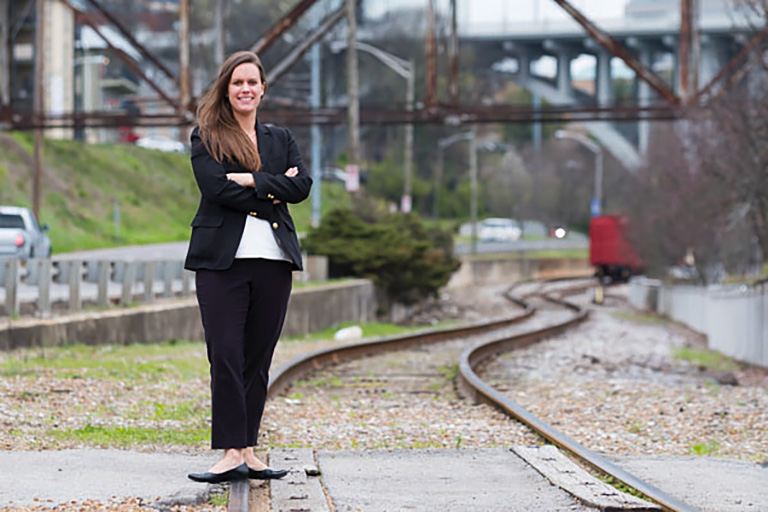By Whitney Heins

If you are meeting Candace Brakewood somewhere, there’s a good chance she may ask you how you got there.
“I have a genuine interest in how people travel,” explained the assistant professor of civil and environmental engineering. “I think what makes me different from most civil engineers is that I’m most fascinated by the human aspect of transportation.”
This fascination was sparked during a study abroad semester in Zurich, Switzerland. The mechanical engineering major at Johns Hopkins University was introduced to the country’s robust rail system. It was easy for people to use, comfortable, efficient, and almost always on-time.
“I started to wonder why we don’t have systems like this in the US that people can use.”
Upon graduation, Brakewood changed her engineering area of focus from mechanical to civil, pursuing a master’s degree in transportation at MIT and later a PhD in civil engineering at Georgia Tech. Today, the professor is covering new ground in transportation-related behavior research while teaching the fundamentals and planning of transportation to UT students.
As a millennial, with a “smart phone attached to my hand,” Brakewood is particularly interested in how mobile phone applications influence behavior. Apps that reveal real-time public transit vehicle location information, enable travelers to buy tickets, and make it easy to hail a ride are disrupting people’s transportation habits.
—Candace Brakewood
In one of her studies of New York City Transit, the answer was a resounding “yes!”
Brakewood obtained three years of data from the city’s transit authority and, through statistical analyses, uncovered the impact the city’s new bus time app had on ridership. Controlling for factors such as fares, local socioeconomic conditions, and weather she found an increase of almost two percent in ridership—which is a lot considering upwards of a million people use buses in New York City each day.
“That’s a lot more people using public transportation each day,” said Brakewood. “And, public transportation is a sustainable and environmentally-friendly mode, so it is a good thing if more people are using it.”
Brakewood is currently collaborating with people at a popular app, simply called “Transit,” to study how users interact with it. (The UT community can thank Brakewood for adding Knoxville to its 125-city roster.) The app shares the whereabouts of buses and trains and/or their schedules. If a user makes an inquiry, such as for a specific bus route, the app stores that data, and Brakewood is tapping into it to investigate specifically how people use it to travel between cities. For instance, if a New York City resident moves to Los Angeles, will they use the same modes of transportation?
The Transit app is adding new features like the ability to reserve a bike in a bike share program or a ride with ride-hailing companies like Uber or Lyft, and Brakewood plans to explore how people use these shared modes as well.
In another study, the researcher conducted a study of regulations of such ride-hailing companies in major US cities providing useful information to policymakers.
In another project, Brakewood is examining the usefulness of mobile apps where travelers can purchase tickets. She surveyed New Jersey transit mobile app users to see if they would be okay with the app using their location to customize information, also known as geo-targeting. Preliminary results show most travelers responding favorably to the practice with a high interest in alerts when rides were delayed or could be impacted by special events.
The common thread through all these projects is Brakewood’s hope that they arm city planners with information to design better transportation systems.
“We need to be thinking towards the future,” she said. “As we become increasingly more reliant on our devices as we travel, we need to understand the implications for this on infrastructure.”
The use of mobile apps is drastically changing the way many of us travel. And, as these changes continue, Brakewood will only become more interested in the way we get from place to place.